Coupling between Cavity Resonances and Characteristic Modes on Household Appliances
Abstract
:1. Introduction
2. Materials and Methods
2.1. Theoretical Analysis
- Waveguide modal analysis
- Cavity modal analysis (RMs)
- Characteristic modes analysis (CMs)
2.1.1. Waveguide Modal Analysis
2.1.2. Cavity Modal Analysis RMs
2.1.3. Characteristic Modal Analysis CMs
- J is the total electric surface current on the surface of a conductive body.
- Jn is the modal electric surface currents composing the total electric surface current.
- An is the modal excitation coefficient.
- Any PEC body delimited by an open or closed surface (S) is associated with an eventually infinite set of real modal characteristic surface currents (Jn).
- Each modal surface current (Jn) radiates a characteristic electric field (En) into the free space.
- The tangential component of (En) on (S) is equiphasic.
- There is a “characteristic angle” (90–270°) defining the phase lag between (Jn) and tangent component of (En) and associated with each CM.
- The orthogonality of (Jn) over (S) as well as the orthogonality of (En) with respect to the radiation sphere at infinity enables CMs to function as a valuable basis set in expanding any potential surface currents and fields associated with the conductive structure.
2.1.4. Two Separated Spaces
2.1.5. Coupling between RMs and CMs
Mij = Mj (FCi)
- HAt (CMj)—Transverse magnetic field on outside region “A” due to j-th “characteristic mode” CMj
- Mij—Equivalent magnetic surface current at aperture due to j-th “characteristic mode” CMj at the i-th resonant frequency FCi of the cavity
- FCi—Frequency of i-th resonant mode RM of the cavity
- HAt (Mij)—Transverse magnetic field on outside region “A” due to equivalent magnetic surface current on aperture Mij
- HBt (Mij)—Transverse magnetic field on cavity inside region “B” due to equivalent magnetic surface current on aperture Mij
- Mijn—Expansion functions at j-th “characteristic mode” CMj and at i-th resonant frequency FCi of the cavity.
- Vijn—Scalar coefficient of linear combination
2.2. Simulation Analysis of the System
2.2.1. Resonant “Internal” Cavity Modes
2.2.2. Characteristics “External” Modes
2.2.3. Resonant Mode RM#0 at 300 MHz
2.2.4. Resonant Mode RM#1 at 404 MHz
2.2.5. Resonant Mode RM#2 at 555 MHz
2.3. Measurements in Anechoic Chamber
2.3.1. Setup Description
- Semi-anechoic radiofrequency chamber (SAC).
- Metal enclosure of a commercial hob, empty of components (DUT)
- Log-periodic antenna for the 80 MHz–1000 MHz range in vertical and horizontal polarizations powered with 46 dBm.
- A calibrated electric field probe (E field sensor).
2.3.2. Reference System
- Radiation direction: yellow dot line (Y-axis)
- Polarization of the radiated field: vertical (Z-axis)/horizontal (X-axis)
3. Results
3.1. Simulation Plane Wave Irradiation
- “Wave-A” → Vertical polarization (X-axis) → Electric field 1 V/m
- “Wave-B” → Vertical polarization (Y-axis) → Electric field 1 V/m
3.1.1. Plane Wave at 300 MHz–Reference Case
3.1.2. Plane Wave at 404 MHz
3.1.3. Plane Wave at 555 MHz
3.2. Real Anechoic Chamber Measurement
- RM #1-RESONANCE MODE AT 404 MHZ
- RM #2-RESONANCE MODE AT 555 MHZ
4. Discussion
Author Contributions
Funding
Conflicts of Interest
References
- Harrington, R.F.; Mautz, J.R. A generalized network formulation for aperture problems. IEEE Trans. Ant. Prop. 1976, 24, 870–873. [Google Scholar] [CrossRef]
- Butler, C.M.; Rahmat-Samii, Y.; Mittra, R. Electromagnetic Penetration through Apertures in Conducting Surfaces. IEEE Trans. Electromagn. Compat. 1978, EMC-20, 82–93. [Google Scholar] [CrossRef]
- Harrington, R.F.; Mautz, J.R. Characteristic Modes for Aperture Problems. IEEE Trans. Microw. Theory Tech. 1985, 33, 500–505. [Google Scholar] [CrossRef]
- Leviatan, Y. Low-Frequency Characteristic Modes for Aperture Coupling Problems. IEEE Trans. Microw. Theory Tech. 1986, 34, 1208–1213. [Google Scholar] [CrossRef]
- Harrington, R.F. Resonant behavior of a small aperture backed by a conducting body. IEEE Trans. Antennas Propag. 1982, 30, 205–212. [Google Scholar] [CrossRef]
- El-Hajj, A.; Kabalan, K.Y.; Rayes, A. Characteristic mode formulation of multiple rectangular apertures in a conducting plane with a dielectric-filled cavity. IEEE Trans. Electromagn. Compat. 1998, 40, 89–93. [Google Scholar] [CrossRef]
- Ladbury, J.M.; Lehman, T.H.; Koepke, G.H. Coupling to devices in electrically large cavities, or why classical EMC evaluation techniques are becoming obsolete. In Proceedings of the IEEE International Symposium on Electromagnetic Compatibility, Minneapolis, MN, USA, 19–23 August 2002; Volume 2, pp. 648–655. [Google Scholar] [CrossRef]
- Gradoni, G.; Antonsen, T.M.; Anlage, S.M.; Ott, E. A Statistical Model for the Excitation of Cavities Through Apertures. IEEE Trans. Electromagn. Compat. 2015, 57, 1049–1061. [Google Scholar] [CrossRef]
- Kwon, J.H.; Hwang, J.H.; Park, H.H. Improving Shielding Effectiveness of Enclosure with Apertures using Absorbers. In Proceedings of the IEEE International Symposium on Electromagnetic Compatibility, Signal & Power Integrity (EMC+SIPI), New Orleans, LA, USA, 19–26 July 2019; pp. 356–359. [Google Scholar] [CrossRef]
- Araneo, R.; Lovat, G. An Efficient MoM Formulation for the Evaluation of the Shielding Effectiveness of Rectangular Enclosures With Thin and Thick Apertures. IEEE Trans. Electromagn. Compat. 2008, 50, 294–304. [Google Scholar] [CrossRef]
- Lei, G.T. An Efficient and Simple Approach to Computing the Green’s Function for the Rectangular Cavity. IEEE Microw. Wirel. Compon. Lett. 2010, 20, 363–365. [Google Scholar] [CrossRef]
- Liang, C.-H.; Cheng, D. Electromagnetic fields coupled into a cavity with a slot-aperture under resonant conditions. IEEE Trans. Antennas Propag. 1982, 30, 664–672. [Google Scholar] [CrossRef]
- Bailin, M.; Cheng, D. Resonant electromagnetic field coupled into a lossy cavity through a slot aperture. IEEE Trans. Antennas Propag. 1987, 35, 1074–1077. [Google Scholar] [CrossRef]
- Balanis, C.A. Advanced Engineering Electromagnetics, 1st ed.; John Wiley & Sons, Inc.: Hoboken, NJ, USA, 1989. [Google Scholar]
- Li, S.; Wang, B. Field expressions and patterns in elliptical waveguide. IEEE Trans. Microw. Theory Tech. 2000, 48, 864–867. [Google Scholar]
- Garbacz, R.J.; Turpin, R. A generalized expansion for radiated and scattered fields. IEEE Trans. Antennas Propag. 1971, 19, 348–358. [Google Scholar] [CrossRef]
- Harrington, R.F.; Mautz, J.R. Theory of characteristic modes for conducting bodies. IEEE Trans. Antennas Propag. 1971, 19, 622–628. [Google Scholar] [CrossRef]
- Inagaki, N.; Garbacz, R.J. Eigenfunctions of composite Hermitian operators with application to discrete and continuous radiating systems. IEEE Trans. Antennas Propag. 1982, 30, 571–575, Erratum in IEEE Trans. Antennas Propag. 1982, 30, 1268–1268. [Google Scholar] [CrossRef]
- Chen, Y.; Wang, C. Characteristic Modes: Theory and Applications in Antenna Engineering; John Wiley & Sons Inc.: Hoboken, NJ, USA, 2015. [Google Scholar]
- Harrington, R.F. Field Computation by Moment Methods; IEEE PRESS Series on Electromagnetic Waves; IEEE: Piscataway, NJ, USA, 1968. [Google Scholar]
- Rao, S.M.; Wilton, D.R.; Glisson, A.W. Electromagnetic scattering by surfaces of arbitrary shape. IEEE Trans. Antennas Propag. 1982, 30, 409–418. [Google Scholar] [CrossRef]
- Schelkunoff, S.A. Some equivalence theorems of electromagnetics and their application to radiation problems. Bell Syst. Tech. J. 1936, 15, 92–112. [Google Scholar] [CrossRef]
- ANSYS Inc. Available online: www.ansys.com (accessed on 31 July 2023).

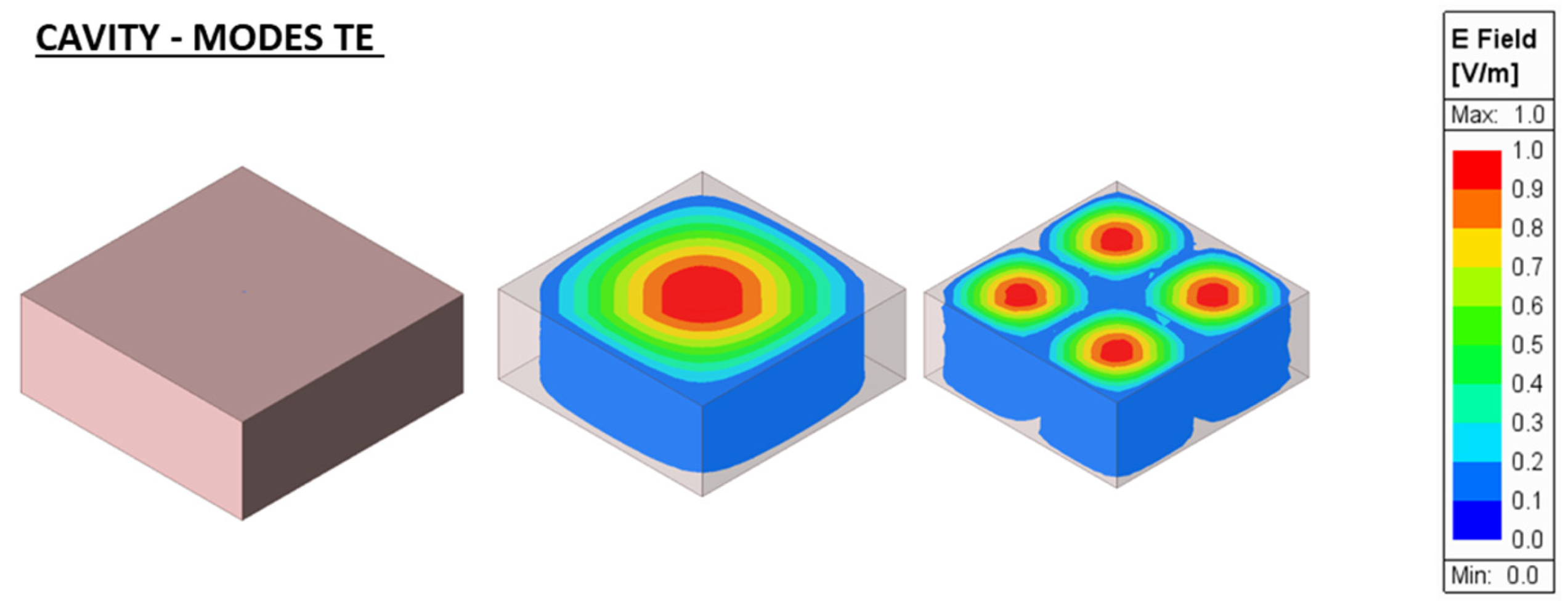

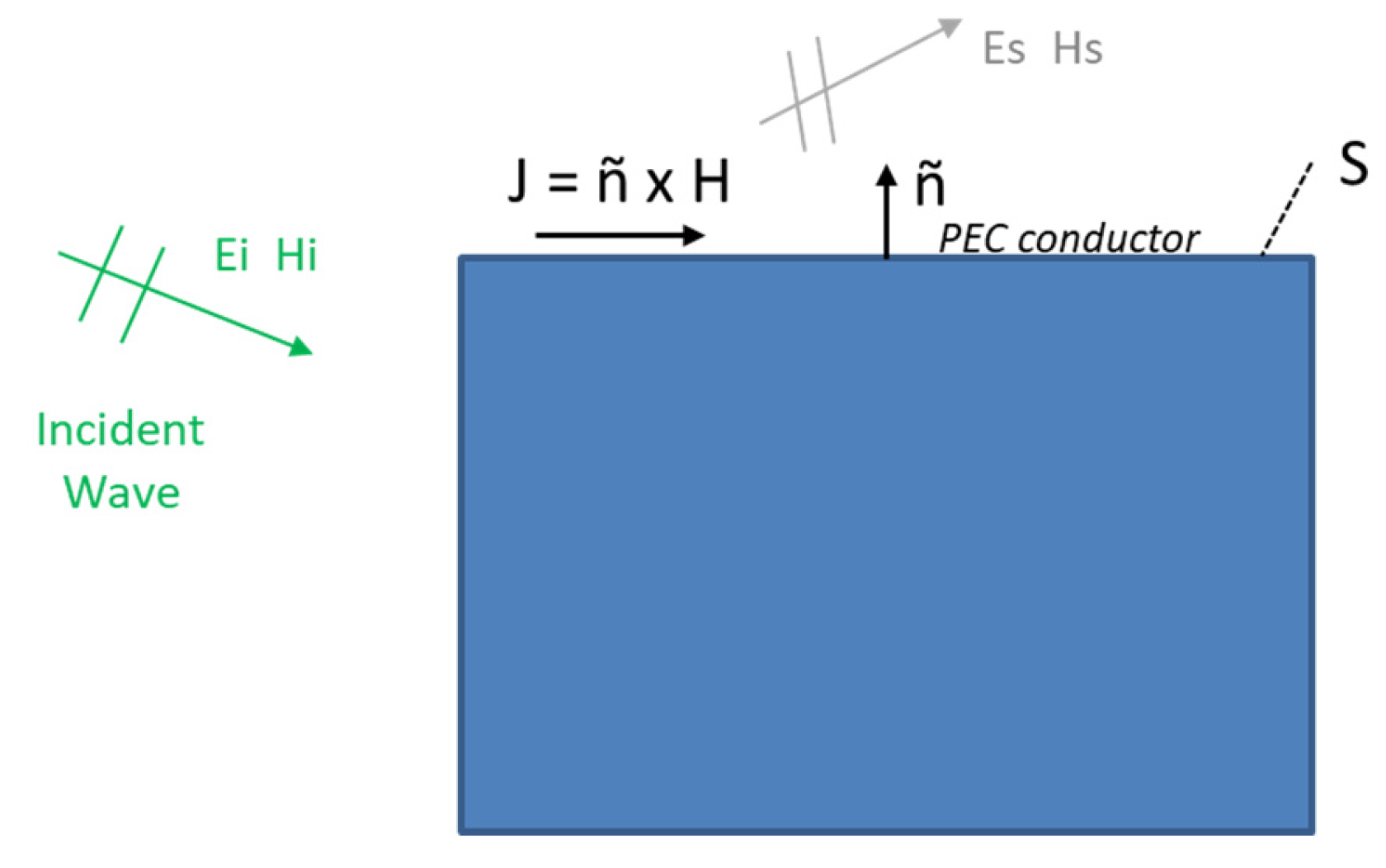
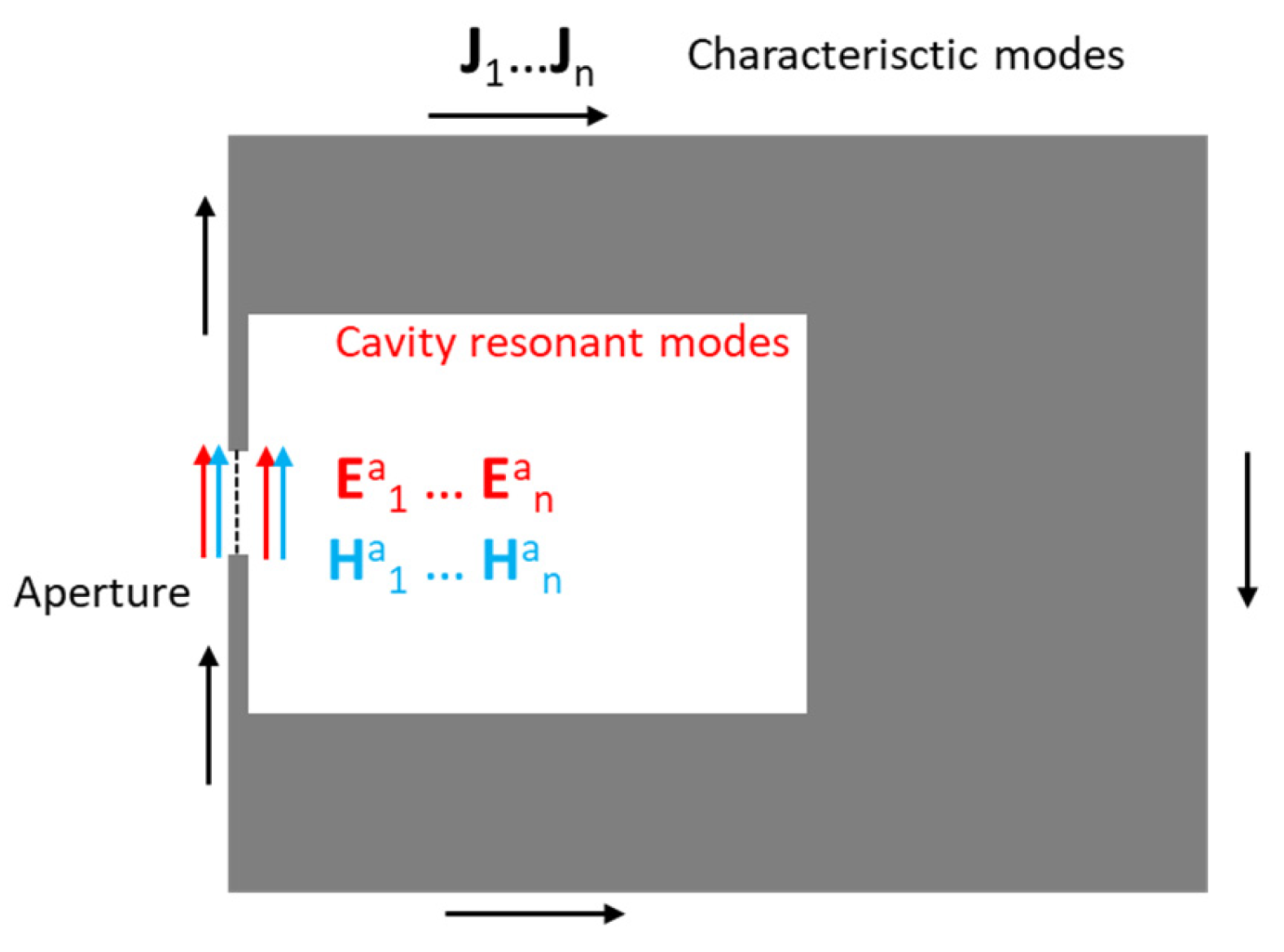







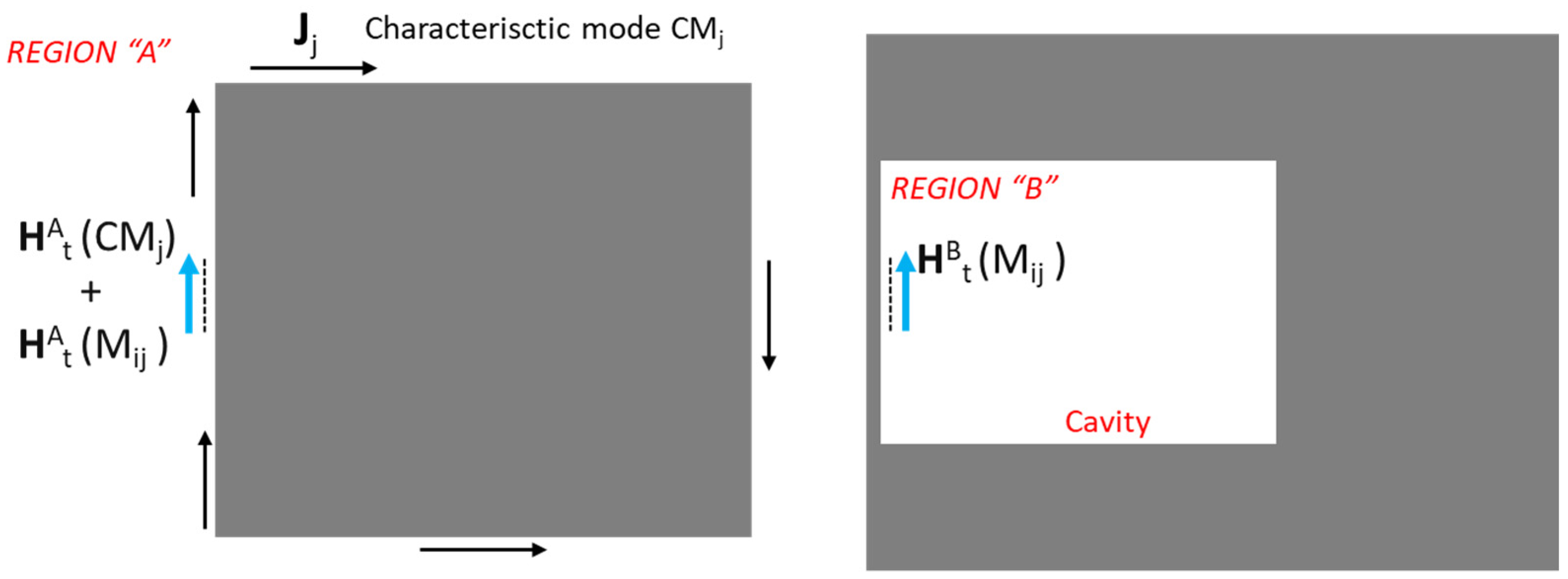

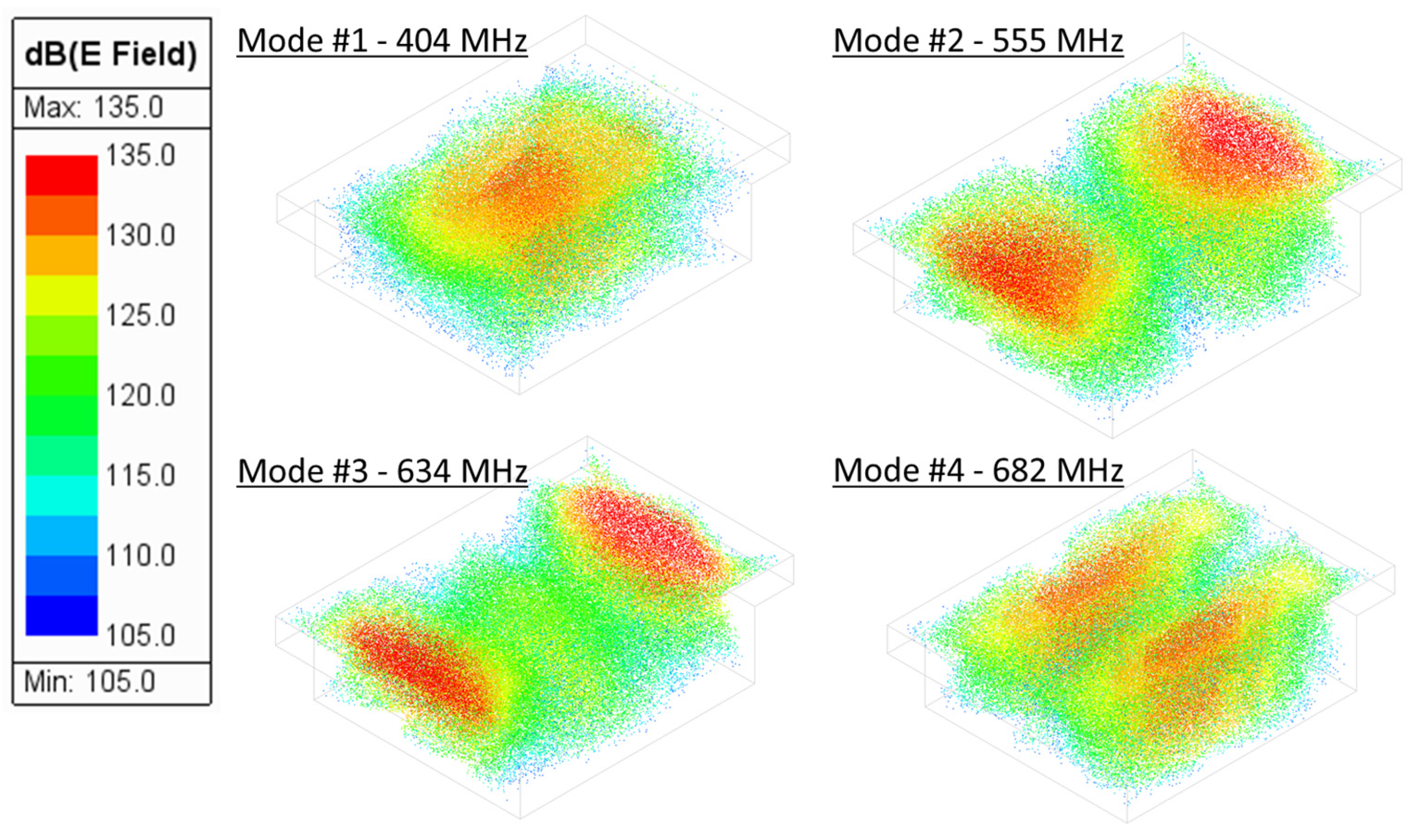

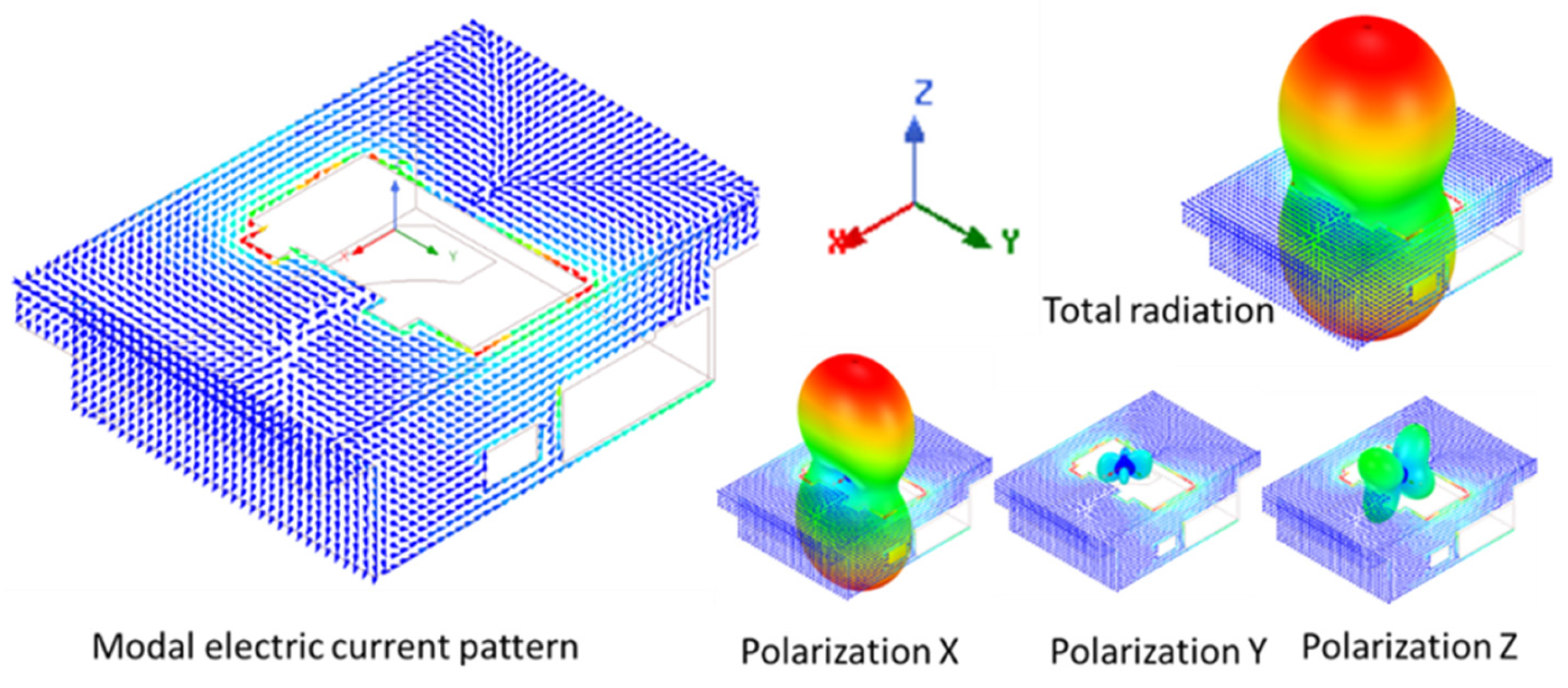
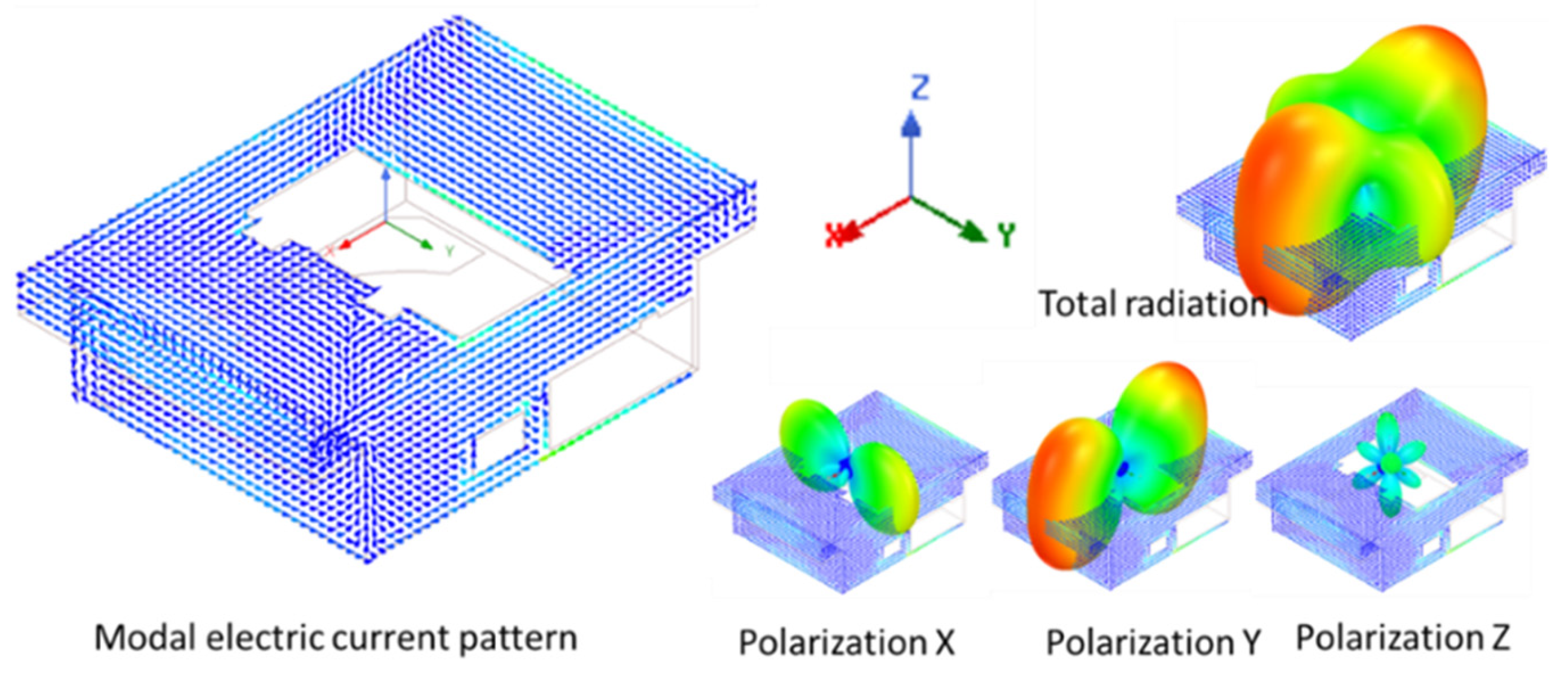

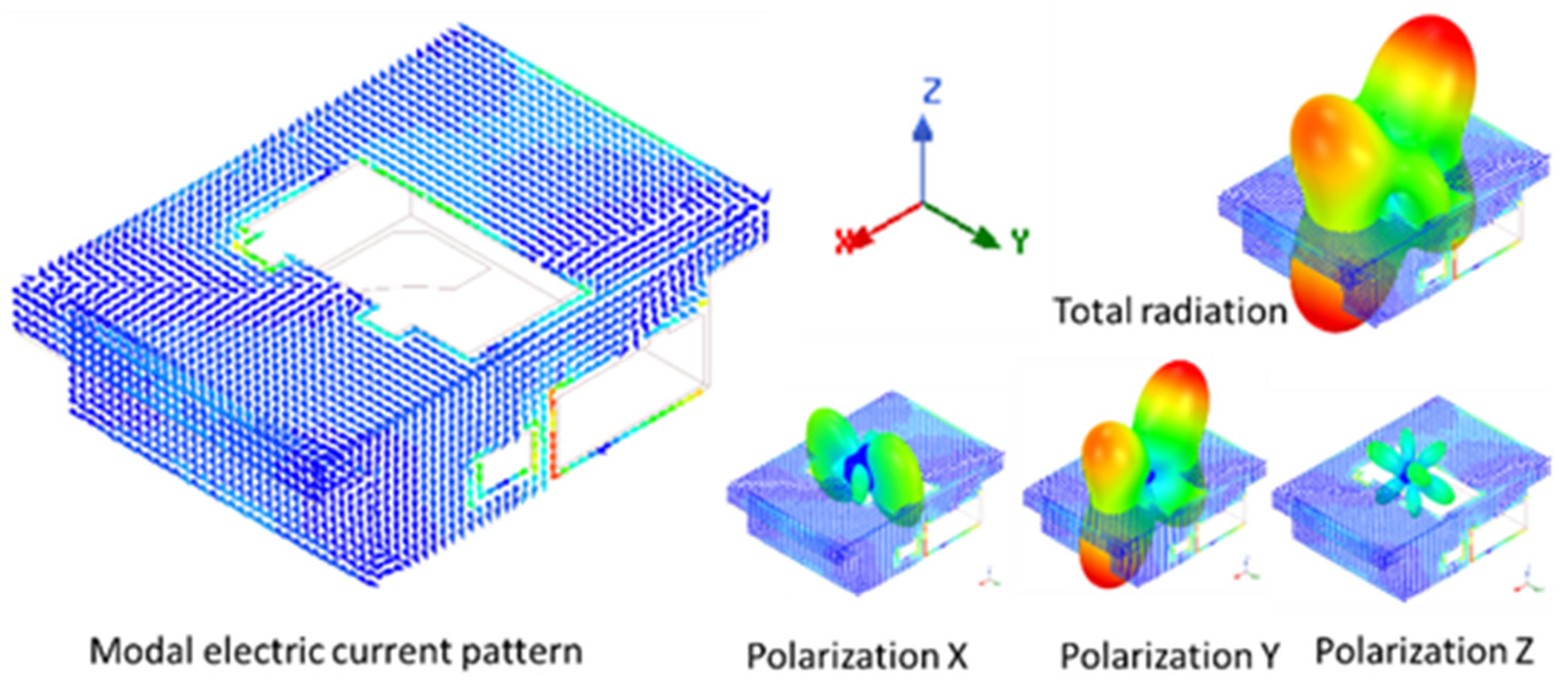

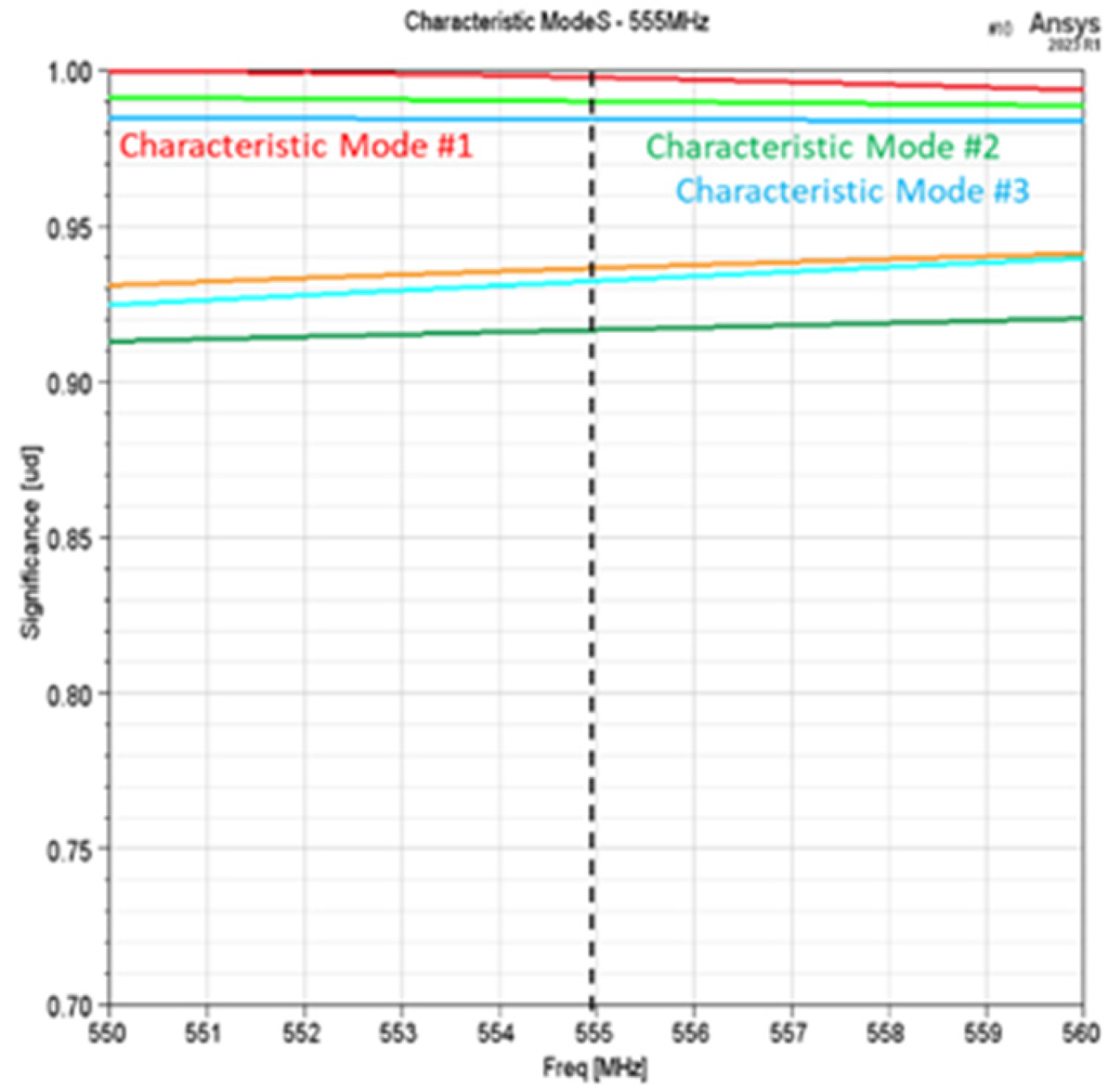

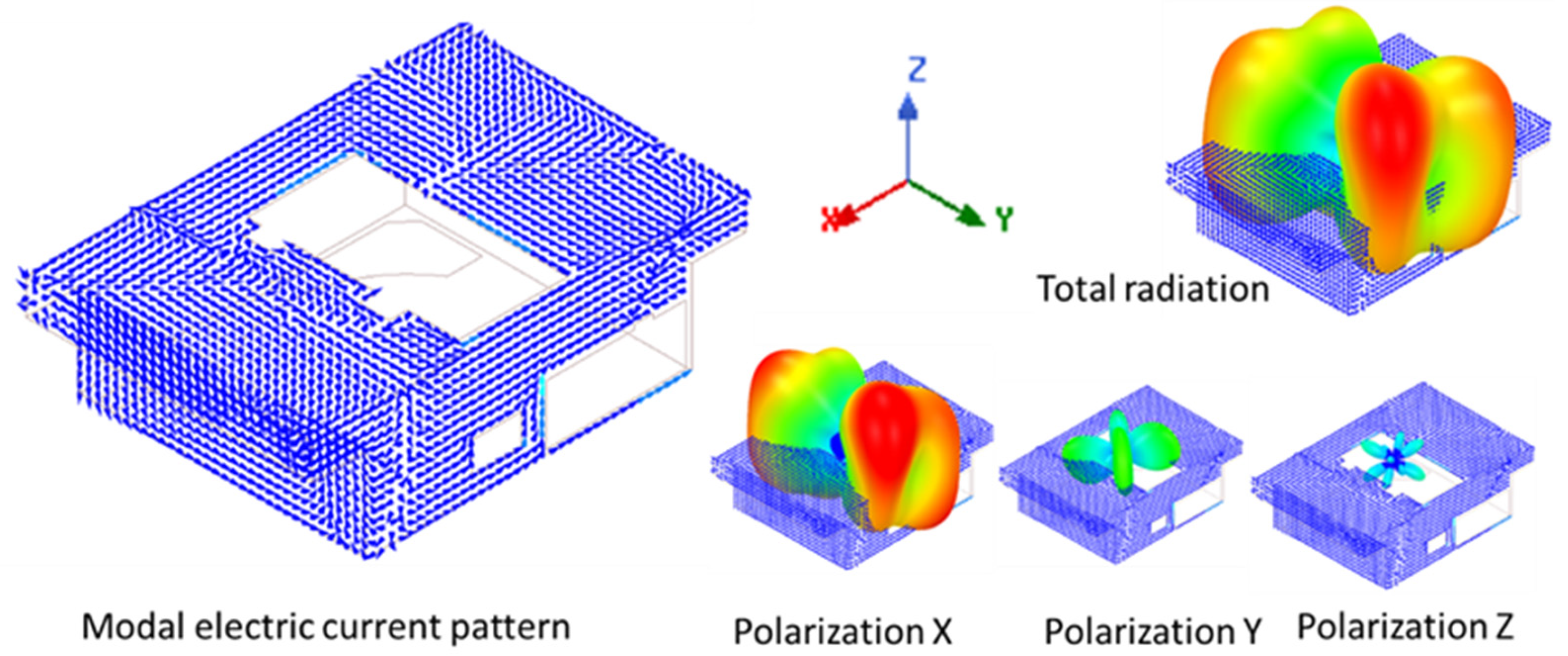
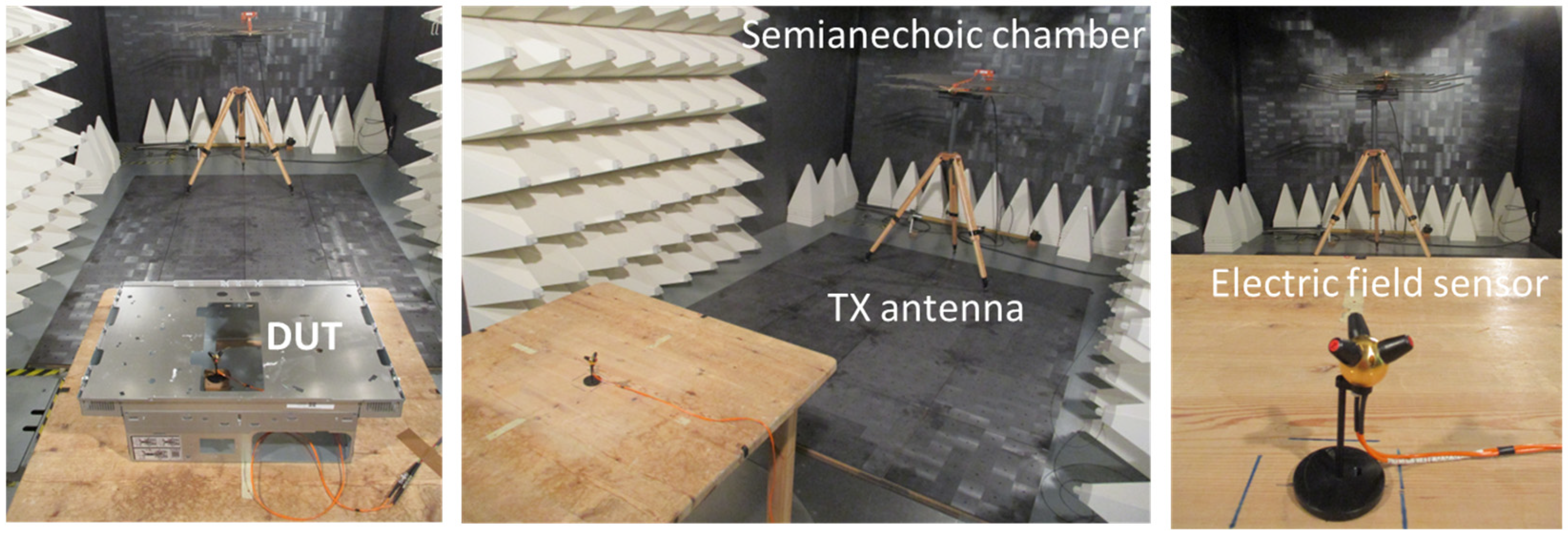
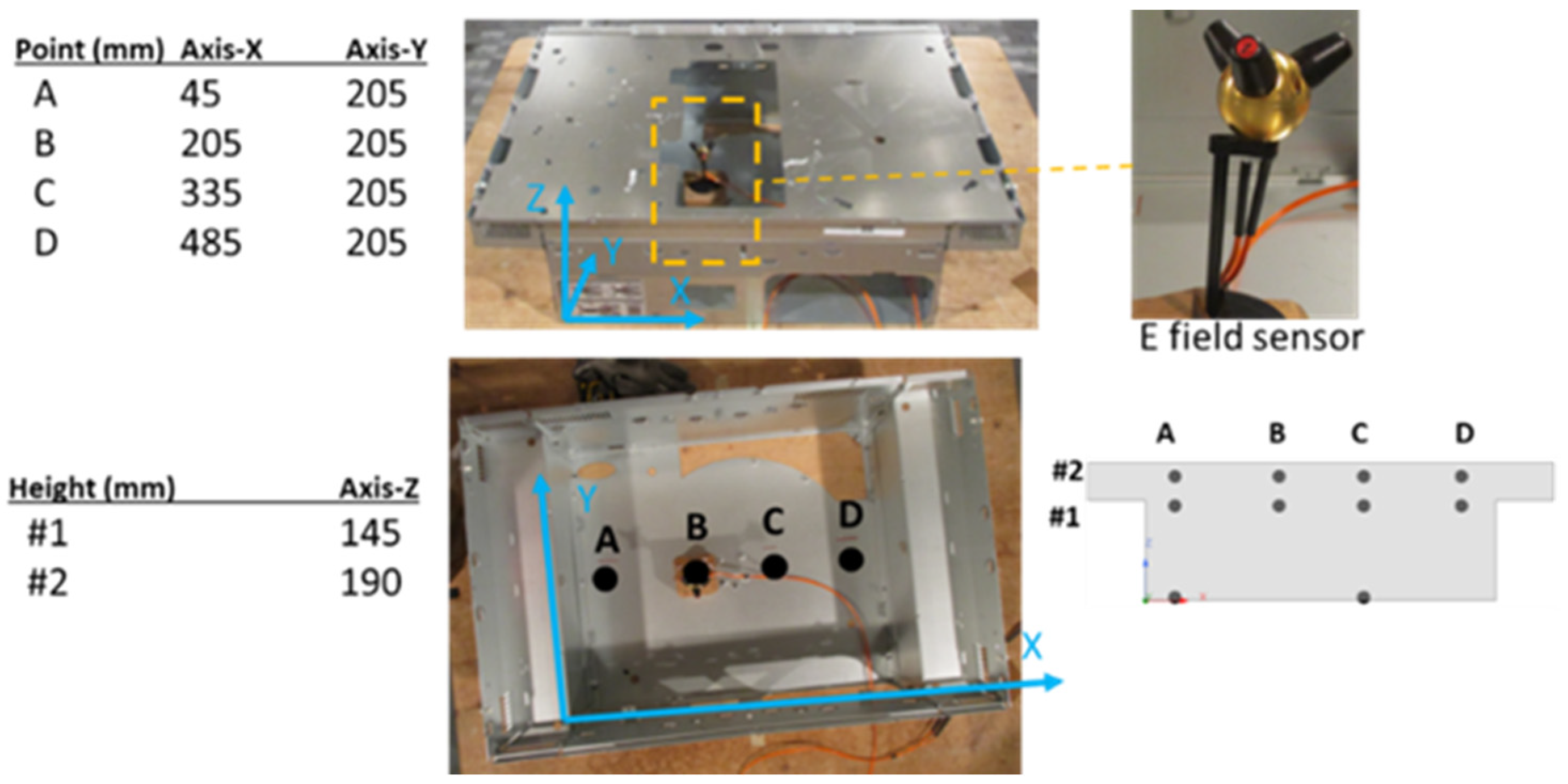


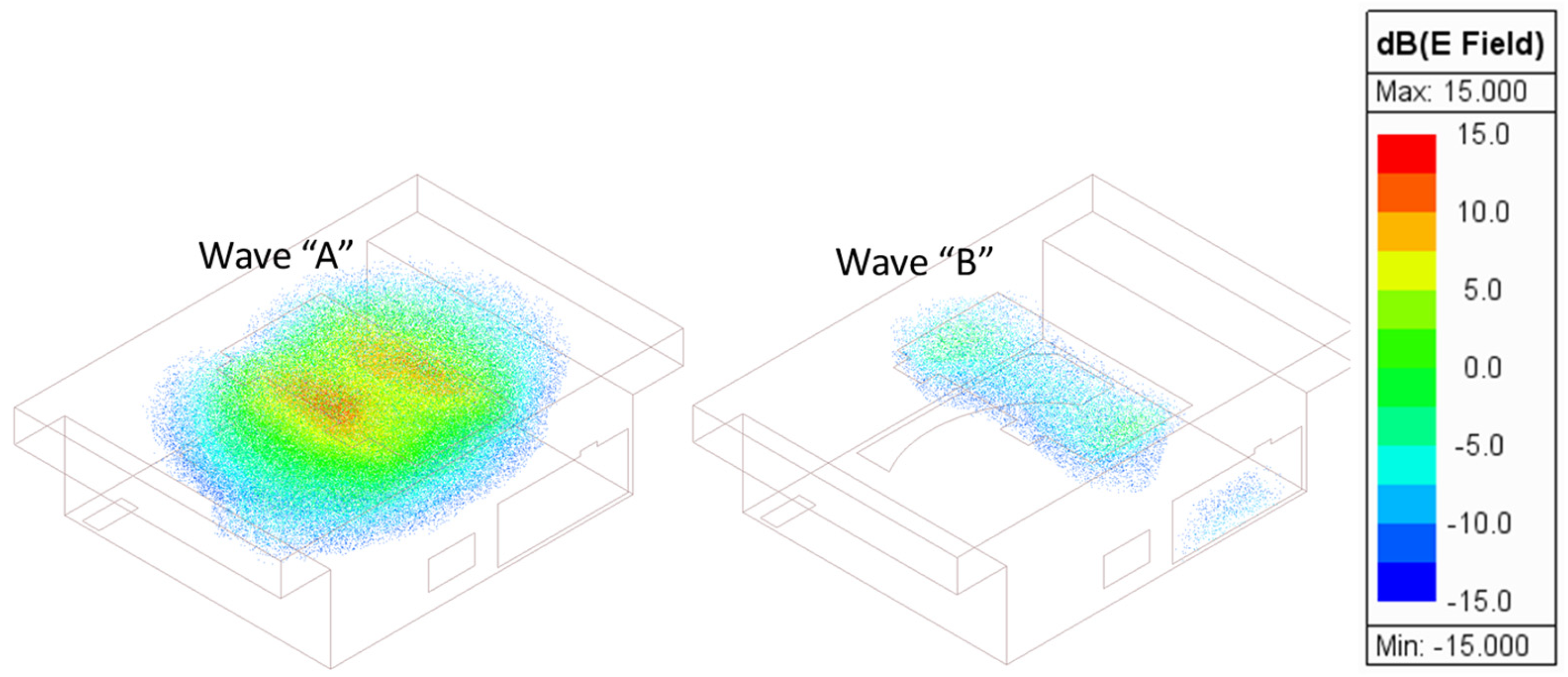
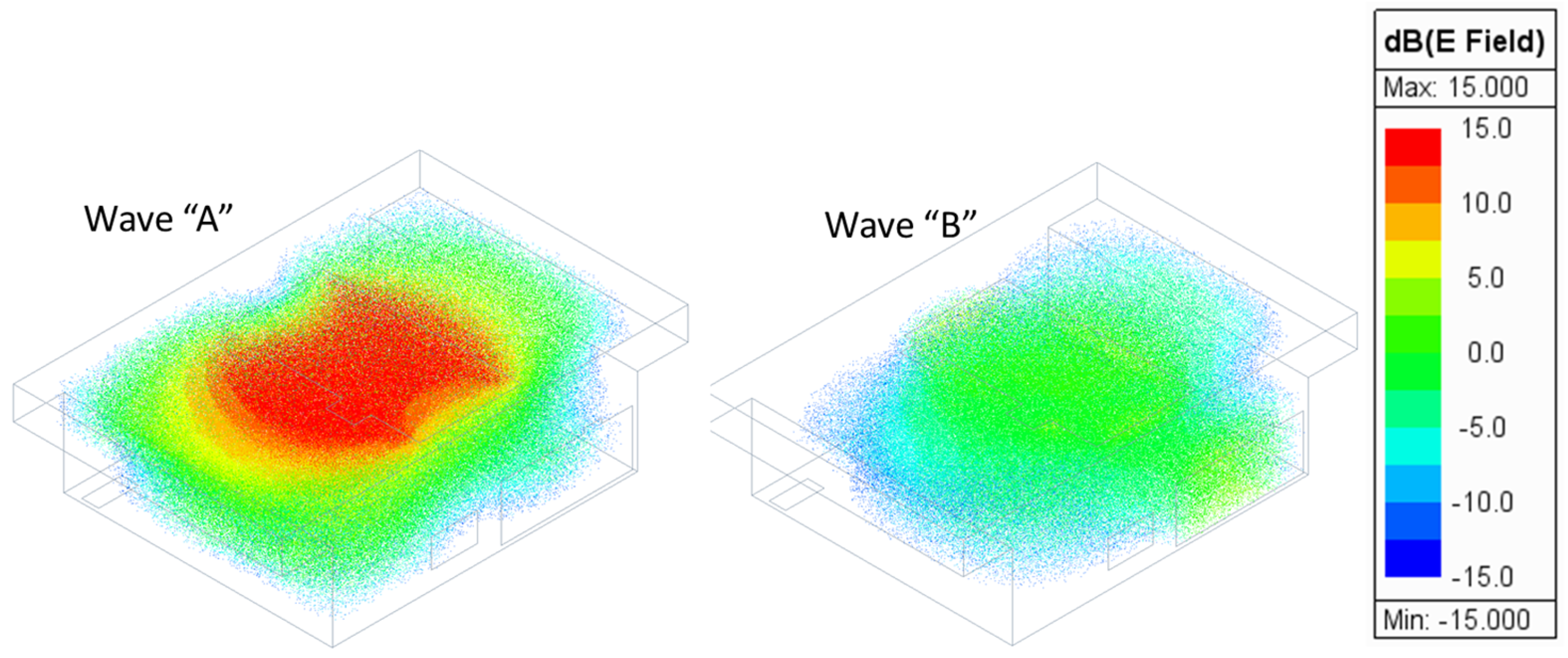
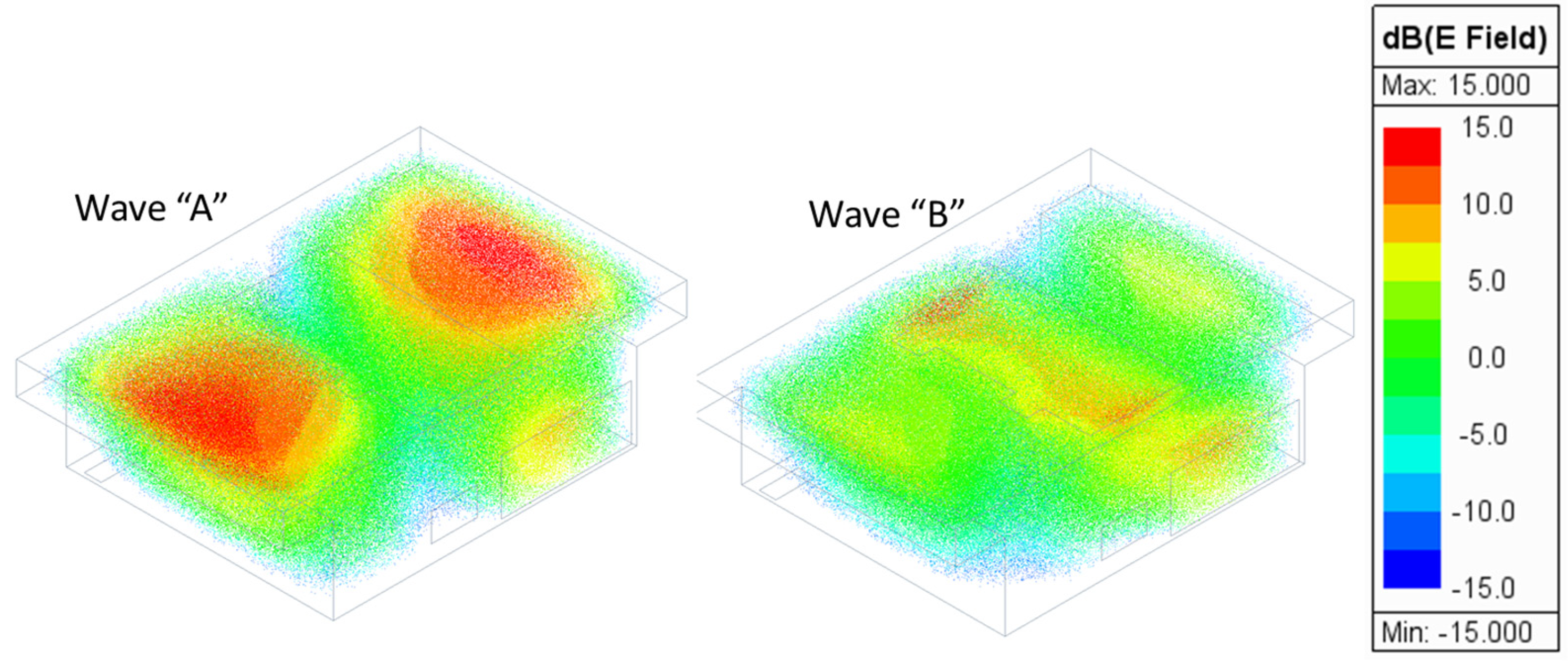

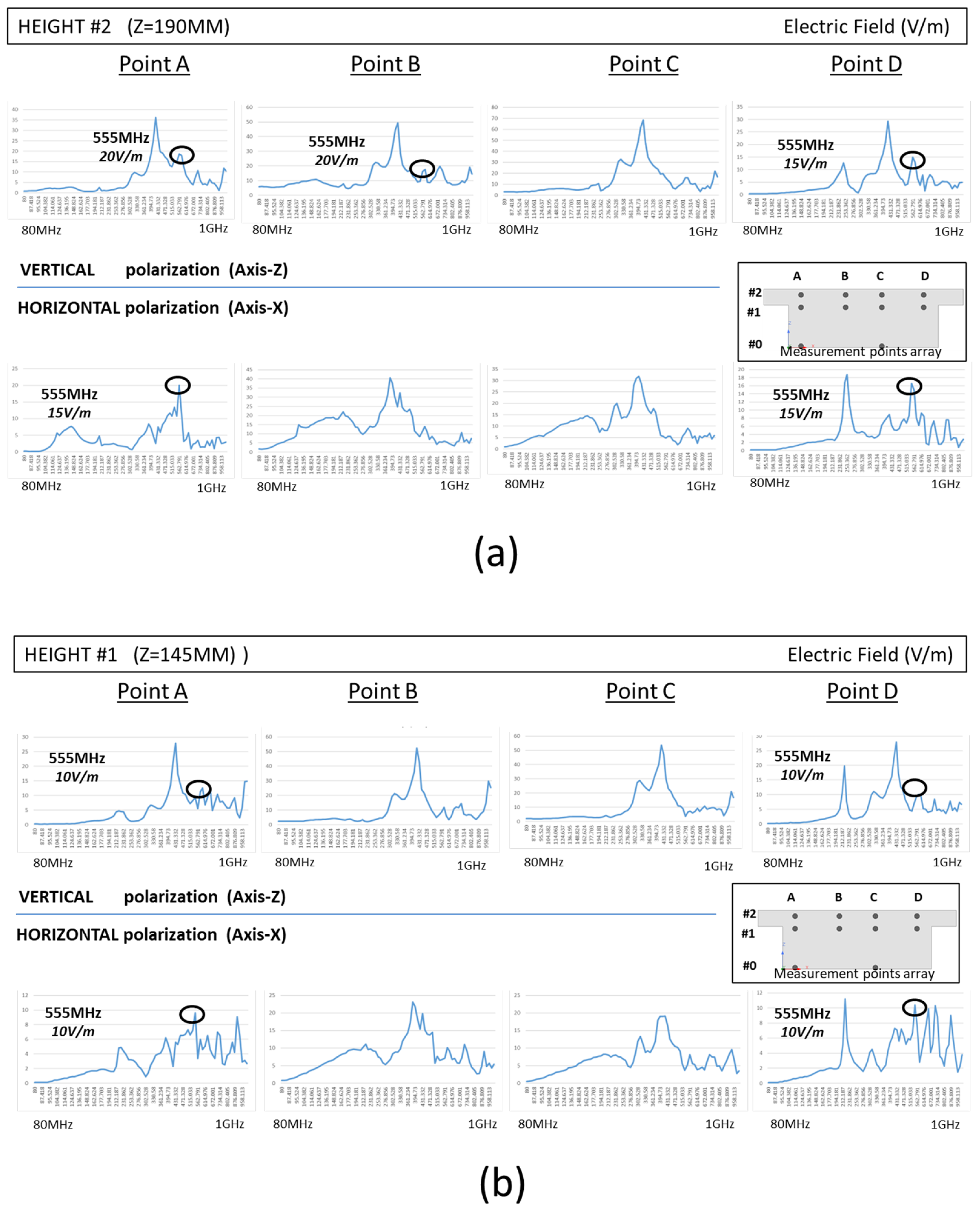
| MODE | FREQ | MODE | FREQ | MODE | FREQ | MODE | FREQ |
|---|---|---|---|---|---|---|---|
| #1 | 404 MHz | #5 | 709 MHz | #8 | 827 MHz | #12 | 901 MHz |
| #2 | 555 MHz | #6 | 764 MHz | #9 | 832 MHz | #13 | 904 MHz |
| #3 | 634 MHz | #7 | 783 MHz | #10 | 841 MHz | #14 | 961 MHz |
| #4 | 682 MHz | #11 | 865 MHz | #15 | 980 MHz | ||
| #16 | 983 MHz | ||||||
| #17 | 995 MHz |
Disclaimer/Publisher’s Note: The statements, opinions and data contained in all publications are solely those of the individual author(s) and contributor(s) and not of MDPI and/or the editor(s). MDPI and/or the editor(s) disclaim responsibility for any injury to people or property resulting from any ideas, methods, instructions or products referred to in the content. |
© 2023 by the authors. Licensee MDPI, Basel, Switzerland. This article is an open access article distributed under the terms and conditions of the Creative Commons Attribution (CC BY) license (https://creativecommons.org/licenses/by/4.0/).
Share and Cite
Labodía, M.; Español, J.; Tesa, J.; Mediano, A. Coupling between Cavity Resonances and Characteristic Modes on Household Appliances. Electronics 2023, 12, 4484. https://doi.org/10.3390/electronics12214484
Labodía M, Español J, Tesa J, Mediano A. Coupling between Cavity Resonances and Characteristic Modes on Household Appliances. Electronics. 2023; 12(21):4484. https://doi.org/10.3390/electronics12214484
Chicago/Turabian StyleLabodía, Miguel, Jorge Español, Jorge Tesa, and Arturo Mediano. 2023. "Coupling between Cavity Resonances and Characteristic Modes on Household Appliances" Electronics 12, no. 21: 4484. https://doi.org/10.3390/electronics12214484







